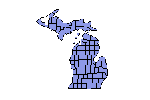 |
 |
 |
|
 Ontonagon County Ontonagon County
Legend says Ontonagon (Nantaonagon) is derived from the Chippewa Indian Language meaning "lost bowl," a reference to a time when a young Indian girl washing dishes at the mouth of the river had a bowl swept away by the current.
While there is a tradition that says that men were working the copper hills of Ontonagon County as long as 4,000 years ago, the first Europeans ever recorded to have visited the area of Ontonagon Country was in the 1600s, when the French trappers came into the area. In 1765, a English fur trader named Alexander Henry explored the region and found large masses of copper. The following year he returned and the Indians showed him a solid mass of copper weighing an estimated five tons. In 1771, while in search of the mother lode that the copper boulder came from, Henry organized the first mining venture in Ontonagon County. When the venture failed, Henry wrote in his journal, "The copper-ores of Lake Superior can never be profitably sought for but for local consumption."
In 1843, James K. Paul removed the copper boulder from its resting place and brought it to the mouth of the Ontonagon River. In a dispute over ownership of the boulder, he was paid $1,365 for his efforts. He used the money to purchase a stock of whiskey and opened the Deadfall Saloon at the mouth of the river, thus founding the village of Ontonagon. The copper boulder, which weighed 3,702 pounds, is now in the Smithsonian Institute.
|
|
|
|
|
|
 |
 |
 |
|
By the late 1840ís, the natural harbor at Ontonagon had become an important shipping point for copper and lumber. Nearby mines, including Minesota, Mass and Victoria brought in men and supplies through Ontonagon.
The word was out about the abundance of copper in the hills twelve miles south of the river mouth. As mining ventures begin in the copper hills the village of Ontonagon, as the only outlet for the copper to market, boomed. When Ontonagon County was formed in 1848, encompassing much of what is now Gogebic County, Ontonagon was named the county seat. In the 1850's, at the height of the copper boom, Ontonagon reached a population of 6,000. The Minesota Mine, operating near Rockland, from 1846-1865, paid out millions of dollars in dividends.
By the 1880s the copper boom was over. Ontonagon County found some prosperity in one of its natural resources, the vast stands of giant white pine. Over the next two decades millions of board feet of lumber were cut and shipped to markets in the big cities to the south. With the logging, came the development of the southern part of the county. Ewen became a large boom town, even rivaling Ontonagon for the county seat. One can still see some stands of white pine and virgin hardwoods while hiking in Porcupine Mountain State Park.
Over the years, Ontonagon County has survived with mining and the forest product industry. Today Ontonagon County has had to rely on one of its natural resources, its beauty, as tourism became the only way for the area to survive. Each year millions of visitors come to Ontonagon County for its many recreation and tourist activities.
|
|
|
Visit our Sister Site: Pasties, Plain & Simple
|
|